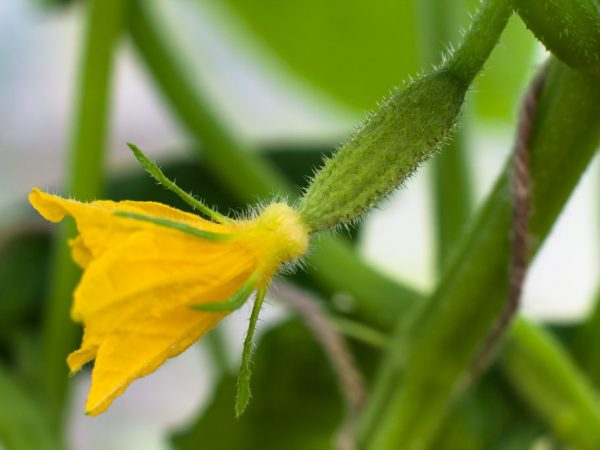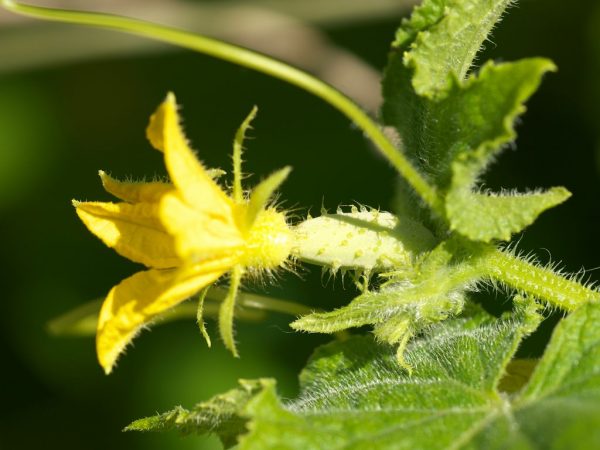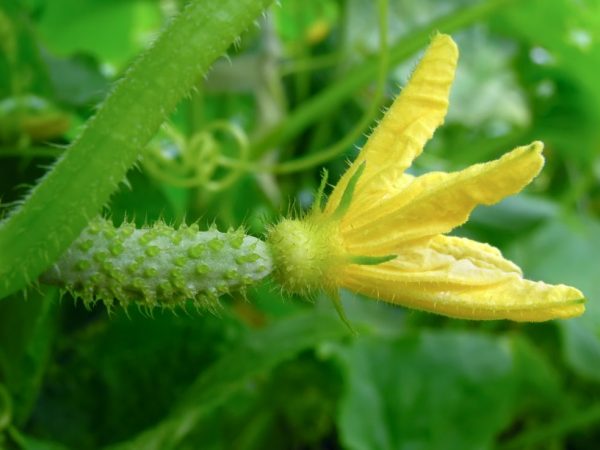Characteristics of parthenocarpic cucumbers
Cucumbers are a vegetable crop that is very popular due to its taste and dietary properties. The plant was cultivated for a long time, more than 4 thousand years ago. But cultivation has always been problematic because cucumbers are very demanding on temperature and humidity, are susceptible to diseases, and are dependent on pollination by insects. The parthenocarpic cucumber variety is a great opportunity to avoid a situation where the material and labor costs of caring for the crop do not pay off due to the low fruit setting in cool and rainy summers.

Characteristics of parthenocarpic cucumbers
Parthenocarpics are mainly greenhouse cucumbers. Pollination is a problem in greenhouses. The process of artificial pollination of flowers takes a lot of time and effort for gardeners. This type of cucumber makes the cultivation less labor intensive with a more guaranteed result.
Description of the variety
"Parthenocarp" is a word of Greek origin. Translated means: "parthenos" - "virgin", "karpos" - "fruit", literally "virgin fetus", i.e. the formation of plant fruits without fertilization. Parthenocarp is known in many horticultural and horticultural crops. There are parthenocarpics of apple, pear, tangerine, grapes, tomatoes and many other crops.
Parthenocarpic properties are fixed genetically in different ways (mechanical, thermal, electromagnetic influence). Like any hybrids, even if parthenocarpics produce seeds, they are unable to emerge and develop into an adult plant.
The parthenocarpic cucumber was found naturally in the wild in China and Japan. In the middle of the twentieth century, breeders received the first hybrids of artificially created parthenocraps. Initially, such plants were not widely accepted, since Zelentsi had a length unusual for gardeners - up to 40 cm. Over time, varieties with the usual fruit size appeared.
Difference from self-pollinating varieties
Many gardeners mistakenly identify parthenocarpic cucumbers and self-pollinating ones. The former form fruits on female-type flowers without pollination at all, therefore, seeds are very often completely absent in the fruits. The likelihood of fruit setting is 50 to 90%.
In contrast to them, self-pollinating cucumbers have flowers in which both pistils and stamens are present, i.e. there is no division into male and female. Self-pollination occurs, resulting in the formation of fruits with seeds.
Their common feature: neither one nor the other depend on weather conditions, the work of insects.
Advantages and disadvantages
In addition to the fact that parthenocarpic cucumbers will yield crops even in the absence of pollinating insects, they have a number of other important qualities for the consumer:
- the fruits of such cucumbers are leveled, almost do not differ in size;
- continuously, bear fruit for a long period,
- the greens taste great, there are no traces of bitterness, which is so often found in these vegetables;
- suitable for fresh consumption, pickling, pickling, canned salads;
- for a long time the fruits retain their bright green color, do not turn yellow-brown when ripe;
- the crop yield has good keeping quality, suitable for transportation.
Among the parthenocarpics, there are varieties with bouquet, or bunch, fruiting. Their peculiarity is that several ovaries are formed simultaneously in the leaf axils.
But there are also disadvantages. It happens that when such plants are pollinated by bees, the seeds are tied in some part of the fruit, and the cucumber is deformed, taking the shape of a pear, curling.
Varieties

Cucumbers can be divided according to their ripening dates
There are parthenocarpic varieties of cucumbers with pronounced properties and partially expressed properties. The latter are distinguished by the fact that on the lashes there are female flowers that do not need pollination, and flowers that are pollinated in the usual way. If you choose this variety, then it should be grown next to the plants that form the male flowers in order to increase the degree of pollination.
Depending on the timing of ripening, such non-pollinated hybrids are distinguished:
- early - fruiting in 36-40 days after germination;
- medium - after 45 days;
- late - after 50 days.
Sprinter varieties with a weakly branched bush are distinguished by early fruiting. But after 1.5 months, the lashes will need to be removed after a friendly return of the harvest. Strongly branching varieties have a long growing season, the harvest can be harvested until October.
The use of zelents can also be different: for preparing salads, pickling and preserving, universal - the most suitable for raw consumption and heat treatment.
Breeding
Recall that it is not advisable to cultivate parthenocarpic in the open field, because insect pollination can lead to deformation of the fruit and a deterioration in taste (the appearance of bitterness). Although there are versatile hybrids designed for greenhouse and outdoor use. The cultivation of parthenocarpic cucumbers has its own characteristics.
Seed preparation
If the purchased seeds have not undergone special treatment, they need preparation: soaking and hardening.
To prepare for germination, the seeds are placed in a damp cloth. It should not be allowed to dry out during the day until the seeds hatch. For moisturizing, you can use a special biostimulator. The use of a weak solution of potassium permanganate or hydrogen peroxide will help to decontaminate the seed and at the same time stimulate germination.
To harden the seeds, they are placed in a bag together with a napkin and sent to the refrigerator for 1-2 days.
Growing seedlings

Varieties can be grown in two ways
Parthenocarpic cucumber varieties are grown in a seedling and non-seedling way. In the first case, peat cups are used for sowing seeds (cucumber seedlings are painfully transplanting). The earth is pre-heated (it can be ignited).
The planting material is sealed to a depth of 2-2.5 cm. The temperature until the first shoots is maintained at 25-27 ° C. As soon as shoots appear, it can be reduced to 18-23 ° С, and at night - up to 16 ° С. Watering regularly with warm water.
Plants are transplanted into the greenhouse on which at least 5 true leaves have developed (about 3-4 weeks old). The temperature in the greenhouse must be at least 14-16 ° С
Growing in a seedless way
Plant seeds can be sown on the beds directly in the greenhouse. If it is not heated, you need to wait until the soil warms up to 15 ° C. Cucumbers are a thermophilic culture, the seeds may simply not sprout.
The culture, especially the parthenocarpic cucumber, is responsive to soil fertility. In vegetable training courses, it is recommended to maintain a pH of 6-7. When preparing the soil, manure is usually applied - up to 10 kg per 1 sq. M. Application rates of mineral fertilizers per 1 sq. M:
- nitrogen - 18 g;
- phosphorus - 25 g;
- potassium - 20 g;
- magnesium - 5 g (all standards are given for the active substance).
Sowing (or planting seedlings from cups) into the ground takes place according to the scheme: 0.5 m between the bushes, 1.5 m - between the rows. You need to pay attention to the type of bush, if the plant branches heavily, then it needs much more space for good lighting.
Care
The formation of parthenocarpic cucumbers is different from that of their regular counterparts. Firstly, the central shoot is not pinched, at least until it reaches the height of the trellis (about 2 m). Leave no more than 6 lateral shoots up to 30 cm long, the upper ones up to 50 cm.
Since the properties of parthenocarp are more pronounced in the upper part of the stem, then for abundant fruiting in the lower axils, all leaves and ovaries are removed.
Watering rates and frequency depend on the growth stage and plant variety. During the period of germination and formation of ovaries, moderate watering is carried out. With the appearance of the first cucumbers, the amount of water under the bush is increased from 4 liters to a bucket 2-3 times a week. Agronomists advise to water pickle and gherkin varieties more often.
Watering rules
The main rules for watering are the same as for ordinary cucumbers:
- warm water;
- water at the root;
- choose the right time: before the beginning of fruiting - in the morning, after the beginning - in the evening.
Fertilization with inorganic substances alternates with organic matter. The first time is introduced after the formation of 4 leaves, repeated every two weeks.
Harvesting frequency: gherkins at least once every three days, pickles - daily. If you do not harvest on time, new ovaries will not form, and the fruits will dry out.
Conclusion
The parthenocarpic hybrid (F1), according to many gardeners, requires a lot of care, but the result is a high yield of very good quality. In recent years, new hybrids have appeared, suitable for greenhouses and open ground.
Everyone has the opportunity to choose the best option for themselves: according to the ripening time, the degree of manifestation of properties, according to the purpose and characteristics of the fruit.


